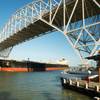How AI Will Boost Sustainability at the Port of Tanjung Pelepas
The Malaysian Port of Tanjung Pelepas is taking the next step on its digitalization journey, tackling congestion and boosting sustainability with a port information management system (PMIS) powered by artificial intelligence (AI).
The Port of Tanjung Pelepas, the 15th busiest port in the world, will deploy Innovez One’s MarineM solution to optimize tug and pilot operations, minimizing delays in the first and last mile of its logistics chains, while simultaneously reducing emissions.
Innovez One has already provided port management information systems to major global players, including the Port of Tanjung Priok in Indonesia, the 22nd busiest port in the world, where MarineM reduced the overall distance travelled during tug and pilot operations by 20%, cutting emissions from these fleets and saving US$155,000 in fuel costs annually. The solution has also reduced the average waiting time for visiting ships from 2.4 hours to 30.6 minutes, slashing emissions further.
Functional support
MarineM will provide the Port of Tanjung Pelepas with a user-friendly interface where agents can register their vessels and order services to support arrivals, such as supplies, logistics and marine services. MarineM will also enable agents to monitor the status of their orders in real time and will automate the billing process.
Using algorithms powered by AI and machine learning, MarineM’s planning module will automatically manage schedules and dispatch resources – assigning pilots and tug boats to their various jobs in the most optimal way and handling the logistics required to transport pilots to boarding grounds.
This significant technological milestone will unlock new efficiencies at the Port of Tanjung Pelepas and ensure that all pieces fall into place seamlessly to support ships’ arrivals and departures. Unlike manual planning, the digital system is able to instantly reallocate resources if a vessel’s estimated time of arrival changes, thereby limiting waiting times and making the port less vulnerable to congestion. It also includes a live map where port managers can view the movement of each vessel.
The power of AI
Where manual processes, spreadsheets and whiteboards fall short, AI-powered algorithms can solve complex puzzles and calculate optimal resource allocation while taking into account a myriad of constraints affecting pilots, tug boats and pilot logistics, including the need to assign pilots to specific vessel types and sizes depending on their license, the types and number of tugboats required for each job, and transfer times from land to pilot boarding grounds.
Ports have diverse conditions, both environmentally and operationally, that make them all different from each other. One of the key advantages of AI-powered algorithms is that they can be trained to learn from a port’s specific marine operations and create optimal solutions that are unique for each port. This level of accuracy helps ensure everything is in place to welcome ships exactly when they arrive – and this improved efficiency is key to helping visiting ships cut their own emissions.
Digitalization helps eliminate problems such as frequent order amendments for pilots, tugs and pilot boards, inaccurate job entries and inefficient scheduling, which can drive down the productivity of ports of any size. AI algorithms are able to adapt to any changes in vessels’ estimated arrival times, updating schedules and reallocating resources at a speed unmatched by manual systems. This gives ports the agility needed to respond to problems or delays elsewhere in the supply chain, which is key to minimizing the amount of time that vessels spend queueing outside ports, with their engines on.
Moreover, by automatically capturing data on each job, from the initial request to billing, MarineM supports transparency and minimizes the risk of errors or disputes. The granular data on operations also helps ports and service providers detect any irregularities more easily, thereby preventing misuse of assets such as the illegal use of water or fuel theft.
Ready for the digital era
At the moment, ports around the world are at very different stages in terms of digitalization, with many still relying on paper and whiteboards for fundamental operations such as the management of their tug and pilotage services. Even those that do have digital solutions in place often work with fragmented or legacy systems that require a lot of human intervention and result in a lot of inefficiency. Many don’t have a smart Port Management Information System, and as a whole the ports sector is yet to make the most of AI.
Of the 4,900 ports in the world, we estimate that 80% still manage operations through spreadsheets and whiteboards, which inevitably leads to inefficiencies that inflate fuel consumption and emissions, and get in the way of achieving commercial objectives, making any kind of investment in climate resilience or emissions reduction harder to justify.
Meanwhile, ports who embrace digitalization today do not only improve their immediate efficiency and carbon footprint – they also build the foundations of their long-term sustainability ambitions, and will be in a prime position to seize the business opportunities of the decarbonized supply chains of the future. We are glad to welcome the Port of Tanjung Pelepas as it joins the growing ranks of the fully digitized ports of tomorrow.












